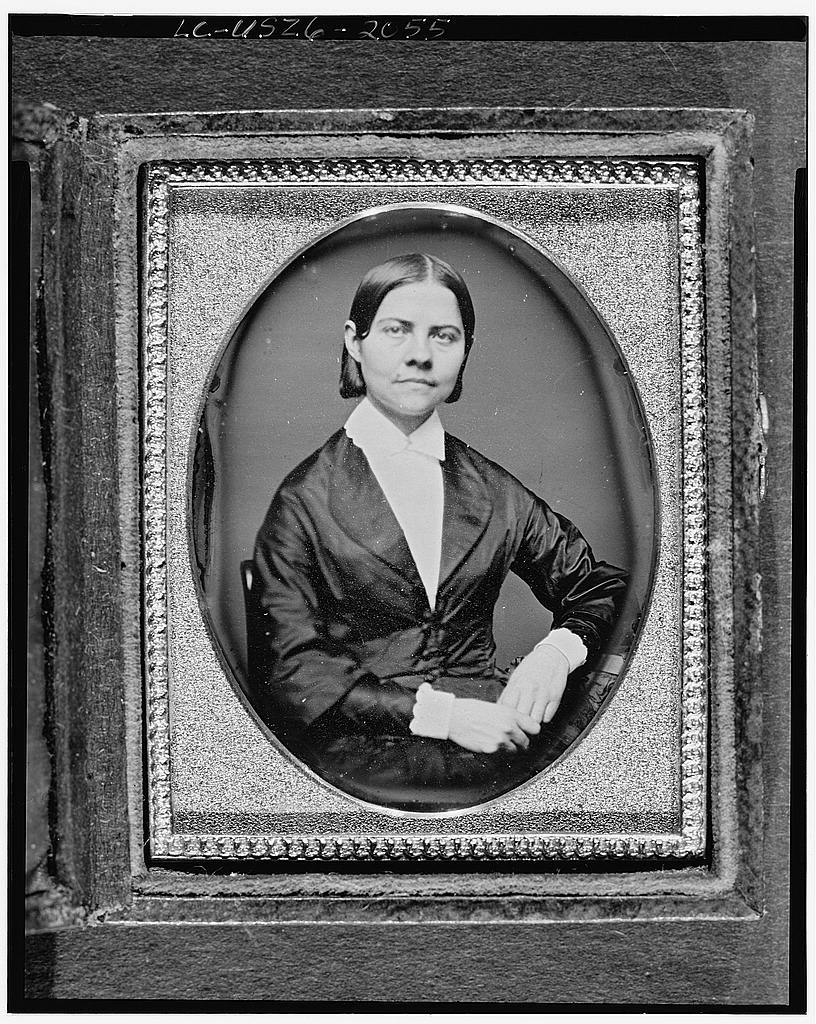 Lucy Stone, a leading suffragist, abolitionist, and renowned orator, is one of the three women honored by the Boston Women’s Memorial on the Fairfield-Gloucester block of the Commonwealth Avenue Mall. The three women venerated – Lucy Stone, Phillis Wheatley, and Abigail Adams – share a Boston connection, a place in national history, and a passion for social justice.
Lucy Stone, a leading suffragist, abolitionist, and renowned orator, is one of the three women honored by the Boston Women’s Memorial on the Fairfield-Gloucester block of the Commonwealth Avenue Mall. The three women venerated – Lucy Stone, Phillis Wheatley, and Abigail Adams – share a Boston connection, a place in national history, and a passion for social justice.
The Women’s Memorial stands out from other monuments along the Mall. The bronze figures, sculpted by New York artist, Meredith Bergmann are at ground level, not on top of pedestals. The women are shown in casual poses, writing and thinking. Dedicated in 2003, the Boston Women’s Memorial is the newest sculpture on the Mall, donated with funds raised by the Boston Women’s Commission.
Lucy Stone is not widely known in the history of the fight for women’s suffrage, although she dedicated her life to battling inequality on all fronts. Lucy was born in 1818 to a farming family of ardent abolitionists in rural West Brookfield, Massachusetts, and by all accounts, she was a brilliant student. While her older brothers earned higher educations paid for by her father, she was not allowed to attend college. At age 16, she worked as a teacher, saving her money so she could pursue further education. In 1839, she spent a semester at Mount Holyoke, but was forced to return home due to a sister’s illness. Then in 1843, she attended Oberlin College in Ohio – the first in the nation to accept both women and blacks. Lucy Stone became the first woman from Massachusetts to earn a college degree. Oberlin was very progressive for the time, but her interest in public speaking was not supported. At her graduation in 1847, Lucy declined the “honor” of writing a commencement speech that would be read by a man.
After Oberlin, few professions were open to women, however, famous abolitionist William Lloyd Garrison (also honored with a statue on the Mall) hired her, and she began lecturing for his American Anti-Slavery Society. She wrote and delivered abolitionist speeches. It was a risky profession; she was often heckled and threatened, but she was very popular and soon earning more than her male counterparts.
Two years after the famous Seneca Falls Women’s Rights Convention of 1848, planned by Lucretia Mott and Elizabeth Cady Stanton, and attended by Frederick Douglass, Stone organized the first national Women’s Rights Convention in Worcester, Massachusetts. Although the Seneca Falls Convention is considered the beginning of the women’s movement, Stone held that the event in Worcester was a greater milestone, because it was national rather than regional. Her speech at the Worcester Convention was reprinted in the international press and for the following five years she toured throughout the U.S. and Canada giving lectures.
 Henry Blackwell, brother of physicians Elizabeth (the first woman in America to receive a medical degree) and Emily Blackwell, convinced Lucy to marry him, promising they could create an egalitarian marriage. Their ceremony in 1855 omitted the woman’s promise “to obey” as part of the vows and Lucy Stone set a new standard by retaining her maiden name. Their daughter, Alice Stone Blackwell became a feminist and abolitionist and worked with her parents.
Henry Blackwell, brother of physicians Elizabeth (the first woman in America to receive a medical degree) and Emily Blackwell, convinced Lucy to marry him, promising they could create an egalitarian marriage. Their ceremony in 1855 omitted the woman’s promise “to obey” as part of the vows and Lucy Stone set a new standard by retaining her maiden name. Their daughter, Alice Stone Blackwell became a feminist and abolitionist and worked with her parents.
Stone supported the 15th Amendment as it was, breaking with suffragists Elizabeth Cady Stanton and Susan B. Anthony (founders of the National Woman Suffrage Association) who wanted women included with Black men. Stone believed women would win the vote soon and with Julia Ward Howe and others, formed the rival American Women’s Suffrage Association. In 1893, prior to her death, Stone’s daughter Alice and Elizabeth Cady Stanton’s daughter, Harriot Stanton Blatch, played important roles in the unification of the two organizations. Stone gave her last public speech at the World’s Congress of Representative Women that year. Even in death Lucy Stone achieved another first. According to her wishes, her body was cremated, making her the first person cremated in Massachusetts.

